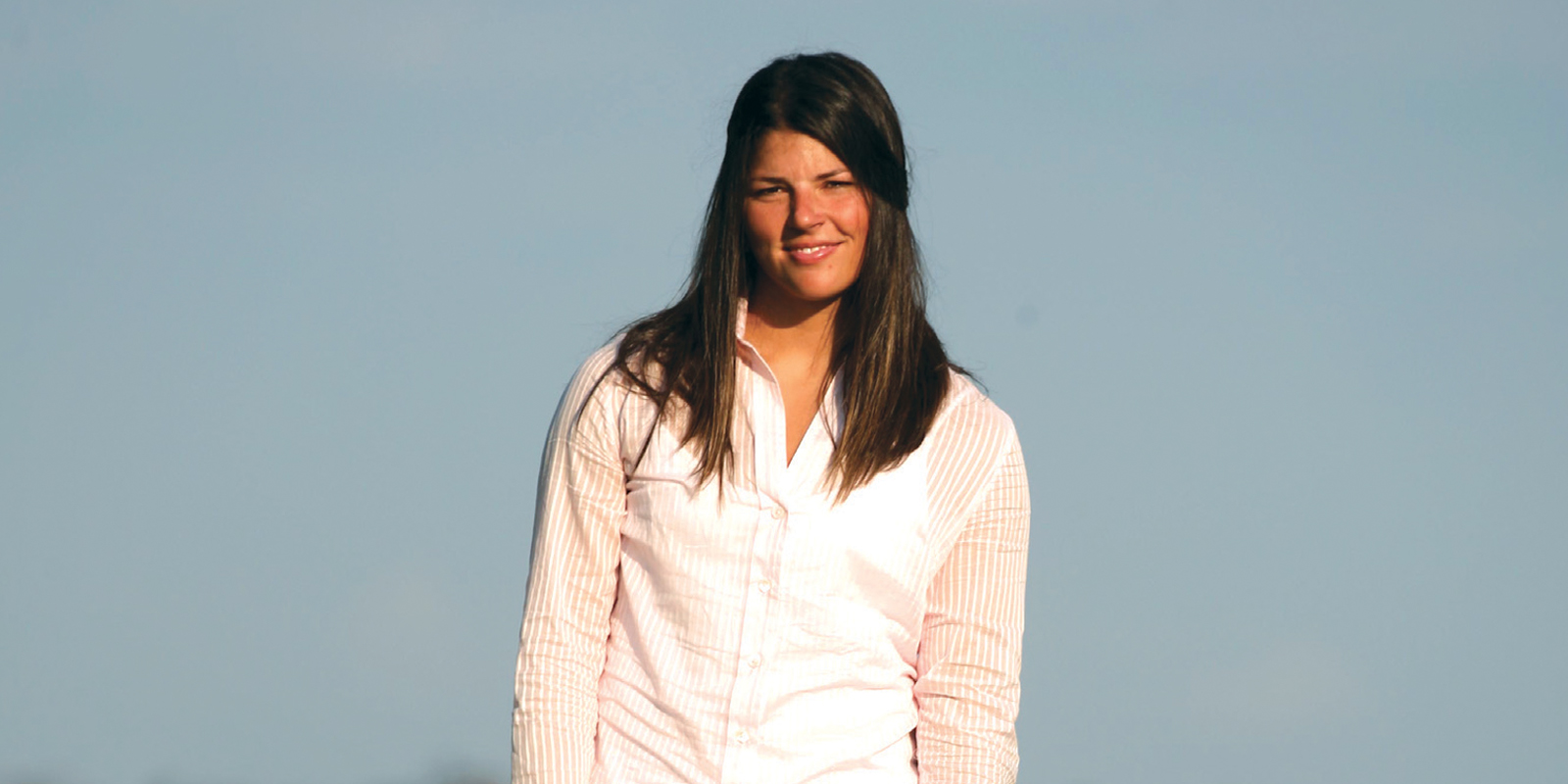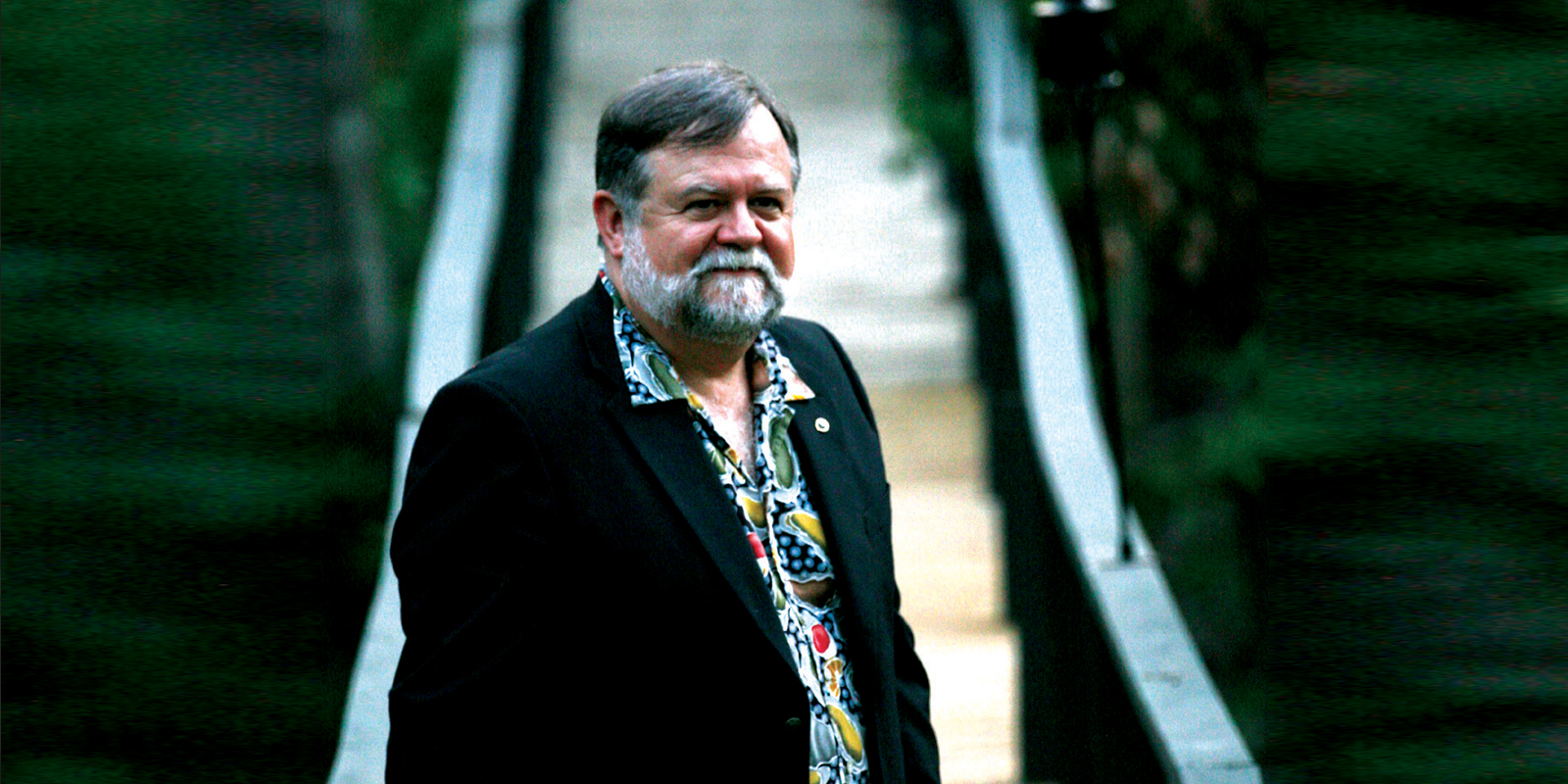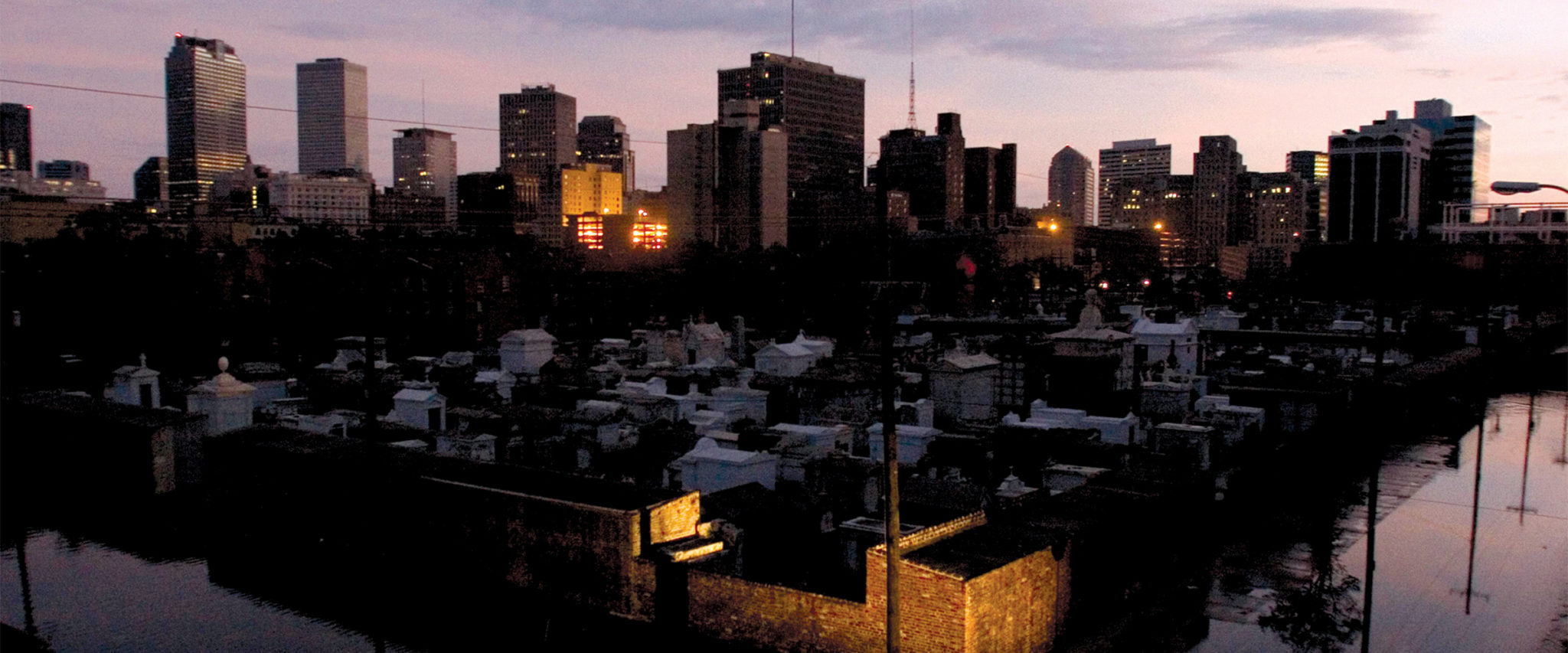Sunday, August 28.
Covington, Louisiana.
The outer ring of Hurricane Katrina had already begun to hit by the time Tom Scheib ’68 finished boarding up the windows of his home on the Tchefuncte River and packed bags for himself, his ailing wife Lynne, and Buddy, their Yorkshire terrier. It was dinnertime. Beginning late the night before and continuing throughout the day, the phone had rung with electronic alerts from St. Tammany Parish, which sits across Lake Pontchartrain from New Orleans, warning of 20- to 30-foot storm surges in low-lying areas and urging residents to get out. Now, he figured, it was too late to evacuate—too close to the storm’s expected landfall, too many jammed in on the highways. Still, he wasn’t too worried. They’d hunker down and ride the storm out. After all, like most New Orleanians, they’d done that before.
A wild rush of wind picked off two trees across the street—snapped, just like that. And the demon force of the hurricane was yet to come. Scheib picked up the phone and dialed a friend up the hill on 15th Street who earlier had extended an invitation. “Guess what, Harry,” he said. “You’ve got house guests.” Laissez les bon temps rouler, as they say.
Thursday, August 25.
Uptown New Orleans.
For Barbara Lachenmaier Spangenberg ’73, community relations director at the nursing home Chateau de Notre Dame, the story begins earlier—on Thursday morning. That was when the administrative staff met in the conference room to discuss the high probability that they would evacuate. Evacuating a nursing home, Spangenberg says, is like moving a battleship. You’ve got to plan early. So they had to make some big decisions well before the hurricane was on the personal radar of most people in the area. Do you move the sick and frail, or do you not? It’s a tall and solid-standing building. Do we really need to move? What’s the worst-case scenario? The decision was colored, in part, by the fact that they had done the arduous and painstaking evacuation for Hurricane Ivan two years earlier, all for naught. Ivan ended up coming ashore further east. Better safe than sorry, they opted again this time. They would move out 50 hours before the expected landfall. Only in hindsight would they see exactly how wise that decision was.
Wednesday, August 24.
The calm before the storm. Baton Rouge.
On the Wednesday before everything would change for New Orleans, Gabrielle Garner ‘04 received a call from her parents, who were on a business trip in Las Vegas. “Gabrielle, are you getting prepared for the hurricane?” they had asked. Garner’s family home is in Mandeville, Louisiana, on the north shore of Lake Pontchartrain, but she was further northwest, in Baton Rouge, where she is a grad student at Louisiana State University. “Hurricane?” she answered her parents. “What hurricane?” In Baton Rouge, she hadn’t been hearing any buzz. Not that she had her head stuck in the mud. Hurricanes happen all the time, no big deal, she says, even now.
Friday morning, she got up to teach her 7:30 Spanish class. But when later classes on the campus were all canceled, she thought maybe she should take a look at the weather. The storm was getting worse and worse, they were saying. It would hit some places head on, but they weren’t sure where. LSU cancelled school for the beginning of the next week and everyone started talking about having hurricane parties. It wasn’t too bad when the storm hit on Monday, Garner says. Some trees came down and it was kind of bizarre because it hit during the day. They couldn’t tell how things were going in New Orleans because television stations in the city were off the air. Then they lost power and really didn’t know what was going on. Garner and her roommate invited their friends over. Everyone emptied their refrigerators and brought the bounty. No school, no work, just getting together and hanging out. Laissez les bon temps rouler.

Friday evening, August 26.
The Saints at the Superdome.
Bill Curl ’62 and his family had a rule of thumb. If you hear the words “in the gulf,” you get on the phone and start making reservations at the most convenient motel you can ?nd out of the path of the storm. Curl, coordinator of media relations for the Superdome, was at a Saints preseason game in the Superdome Friday evening when he saw on the news that it was really starting to look bad. At half-time he got on the phone and found a motel in Greenwood, Miss., almost 300 miles to the north.
The weather was spectacular the next morning. That’s the way it is with hurricanes—everything is jewel bright and kissed by the sun, then the winds pick up and the clouds move in, and you know the rest. Curl and his wife, Carolyn, got on the road around 9 a.m. with the green ?reproof box that carried their important papers and enough clothes for three days. Traf?c was heavier than usual. But it could have been worse. As it turned out, they left, Curl says, just in front of the thundering herd of evacuees.
From their motel room in Greenwood—which, by the way, sustained some damage from the storm even that far inland—Curl and his wife watched television in disbelief. They could see where the outer roof of the Superdome had been stripped. Would there be a building there or not when they went back? They could see video of the Hyatt Regency Hotel next to the Superdome. All the windows were gone, Curl says, all you saw were ragged curtains ?apping out of the windows. And all they could do was sit and worry: Is this what the whole city looked like?

Saturday, August 27.
The battleship Chateau de Notre Dame.
It wasn’t just moving elderly people in varying degrees of health that was a challenge. Evacuating also meant bringing mattresses, wheelchairs, medical equipment and supplies, clothing, records, and food. They had reserved chartered tour buses a year in advance as part of the hurricane planning process required by the city. Only one was equipped for handicapped passengers. They’d use its lift for the sickest patients. But how do you get the other wheelchair-bound patients up the regular stairs?
Barbara Spangenberg’s job on Friday was to go from ?re station to ?re station to ?nd volunteers to carry the patients onto the buses. The ?remen, she ?gured, are trained to carry people. The ?re chief turned her down twice; if they helped the nursing home, they’d have to help everyone. On Saturday morning, Spangenberg sought out a ?reman she knew. Don’t ask your chief, she told him. Can you please just come help us? And if you have a ?re, of course you can go. He came over with three men. When they saw the chaos of the moment, they called another ?re department to pitch in, too. Altogether, eight strapping men carried the patients, one by one, up the steps and onto the bus. It was almost evening till they were all settled and the caravan could leave the city. Destination: St. George’s Catholic Church and School, Baton Rouge. Five buses and two huge trucks and 15 cars carried 105 frail and sick nursing home patients, 30 assisted living residents, eight managers, and 75 staff. Seventy-?ve children were on board, too, because you can’t send off nurses and aides without their families. The youngest among them was three months old; the oldest, 101.
Later, Spangenberg would try to interest reporters in the story of an early, successful, and positive evacuation. No one, she says, wanted that kind of story.
Monday, August 29.
Covington.
It was the most amazing thing, Tom Scheib says. He and the 10 other people who had taken refuge in Harry’s small cottage sat spellbound looking out the windows, watching huge pines and live oaks come smashing down on homes around them. The storm’s constant drone was interrupted only by the terrible snaps and thuds of giant trees cracking away and crashing to the ground—or worse, onto a house. The rain was blown so horizontally, at one point, that it spit through the window panes. Beyond that, it was almost as if Harry’s hundred-year-old cottage was in a bubble. Two trees came down in the yard—one in the front and one in the back—but the house, with the exception of a few slate shingles and some exterior screen frames, held its own.
Scheib found himself mesmerized by the power and destruction. “It catches your whole soul,” he would say later. He and the others were torn between trying to protect themselves and staring outside. “You couldn’t do anything to change what was going on,” he says, “but you felt compelled to watch it as all the houses around us were damaged. Fortunately, there were no injuries. But a lot of shocked people emerged from their houses six to eight hours after the worst started early Monday morning.” Buddy, the Yorkie, was more traumatized by the other two dogs in the house. When he wasn’t keeping company with Lynne, who was trying to rest in a bedroom, he lay with one eye on the window and one eye on the dogs.
Tuesday, August 30.
On the road to Mandeville.
The dog. That’s who Gabrielle Garner worried about most. Boudreaux, who had been in an outdoor/indoor kennel while her parents were out of town, was the one in the family who experienced the hurricane most directly. Garner didn’t know how bad the damage was to her hometown; nothing was coming through on the news. All she knew was that she had to go get her dog, a mutt with Jack Russell terrier/French bulldog bloodlines who Garner says is so ugly that he’s adorable. So the morning after the ferocious hurricane winds, Garner and her younger brother, Paul, an undergrad at LSU, set out on a mission-almost-impossible, trying to go the 70 miles east to Mandeville.
Police weren’t letting people back into town, so they went the back roads, spaghetti-weaving, Garner says, around debris and downed power lines. When they got to the kennel, there was a sign on the door. The vet, who had stayed through the storm, would be back late in the after-noon. Garner went around to the back, calling for her dog. She thought about climbing the fence. What the heck. That couldn’t be more foolhardy than driving through the mine?eld of power lines. But Boudreaux heard their calls through the din of all the yips and woofs and came crying and squealing and jumping up against the fence, trying to get to them.
Once they knew Boudreaux was safe, they decided to come back for him when the vet returned at 4:30. So they drove around Mandeville, ?rst to their house, and then to the houses of family and friends. They took pictures, knowing the question on everyone’s mind: What about my home? At their own place, they found trees everywhere. Treetops leaning against the house, the roof damaged, the back yard a wall of impenetrable green.
Back at the kennel, the thing that broke Garner’s heart was how Boudreaux’s bed was soaked. He had been so scared by the hurricane winds that he peed all over it. They drove back to Garner’s house in Baton Rouge. Boudreaux went into the house, sniffed out a rug by the front door—the one item that was originally from her parent’s house—and settled into it. Not quite home, but close enough.

Wednesday, August 31.
The streets of Covington.
They all came out to look once the winds had blown themselves out. “It’s hard to imagine that you’re so entrapped by all this debris that you can hardly move, you can’t walk,” says Scheib. “You had to climb over trees to get to the next part of the street.” They returned to Harry’s to wait. Monday night. All day Tuesday. Finally, by Wednesday, a swathe being cut through back streets to create a route to the hospital had reached as far as Harry’s place on 15th Avenue. Scheib couldn’t wait any longer. And as ill and weak as she was, Lynne had to come along. They drove the seven blocks that had been carved out down the hill. When they got to the hospital, they got out of their car and continued on foot. Their house sat between the 1st and 2nd avenues. Or at least it had when they ?ed on Sunday. Now to get back home, they had to weave their way around debris that was still right where Katrina dropped it. It was, Scheib says, the longest walk he’s ever taken. “You go by friends’ houses and you think, “Oh my god, we should get hold of them. But maybe they’re better off not knowing.” And then all of a sudden the thought popped up in his head: Well, what about my home?
Later. What is lost.
The electricity was only out for a week in Gabrielle Garner’s part of Baton Rouge. It was boiling hot, maybe 90-some degrees with 90 percent humidity. Everyone’s doors and windows were open and people sat out on their front porches, sweating. There was more traf?c than she’d ever seen in town, but the traf?c signals weren’t operating and it seemed like mayhem was always just around the corner. Driving on I-10 at night, the darkness was complete—no house lights or street lights twinkling. People—even children—came to the back door begging for food or hoping to make a little money doing yard work. Hurricane dogs, the ones displaced along with their humans, were everywhere. The stranded families of students crowded into dormitory rooms with them at LSU.
Garner put up her parents for a week until they decided that despite there being no electricity in Mandeville, no chainsaws available to begin the clean-up, and not much of a roof, they had to be back home. Garner would bring whatever groceries she could gather for them—there were no grocery stores open in Mandeville and the shelves emptied fast in Baton Rouge.
At the shelter in the downtown convention center where Garner volunteered, there were beds everywhere and personal space nowhere. She would see people in bed with their kids in the middle of the day because that was the only place they had to go. Garner served food and stood guard at the shower room, making sure that no men tried to get into the shower when the time was blocked out for women and vice versa. One day, she offered a girl some pink Bath and Body Works body spray that she found gathering supplies to stock the showers. The girl teared up as she sprayed some on and smelled it. “This makes me feel like a person again,” she said.
By the Wednesday following the storm, Barbara Spangenberg was out of a job. When it became clear that the residents would not be able to return to the nursing home any time soon, patients were transferred to other facilities around the state, even around the country. Now, renovations to the Chateau de Notre Dame’s ground ?oor, which took in 16 inches of water, are almost complete. The administration, understandably gun-shy with the next hurricane season approaching, allowed only a few residents to return to a partially restored facility in February.

Spangenberg went on to meet her husband who was by then in Houston. There, a month later, they weathered Hurricane Rita. (It was weeks, says Spangenberg, before she could bring herself to stop carrying a can of gasoline around in her car.) They watched the list of ZIP codes as sections of New Orleans were reopened and braced themselves for the worst. Their house was in the Broadmoor section of the city, not far from the French Quarter. They heard, fourth-hand, that the neighborhood only got 12 inches of water. But one of their daughters recognized a place on TV two blocks from the house. The water was over the stop sign. Spangenberg assumed they had lost everything.
When their zip code ?nally cleared the ?rst week of October, they made the drive back from Houston. Rita had left miles and miles of wreckage along their route. Then they became lulled by untouched vistas. New Orleans, of course, was like a slap in the face. Buildings with windows blown out. Trees and cars all over the place. All the vegetation brown and dead. The foul stench.
As it turned out, the Spangenbergs were relatively lucky. Many in their neighborhood lost everything. They could tell by the “bathtub ring” on the house that the water had been over the top of their van. (They lost two out of three family cars and their 30-year-old boat, which had been tossed 50 feet from its mooring into the middle of a parking lot.) Everything on the ground ?oor had to be trashed. But they were able to hire eight men to come in, remove the sheet rock, and scrub everything down with bleach. Then they had to wait six weeks to see if the mold was going to rise up the walls. It didn’t.
For the time being, they’re living in an apartment in Houston, where Spangenberg’s husband, Rob, was able to transfer his work. On January 20, they sold their house-the same day that electricity ?nally came back. They didn’t get a big price, Spangenberg says, but a fair price. “It’s hard to know if we did the right thing, but we feel we had no choice,” she says. “It’s hard to leave New Orleans.”
In a way, Tom Scheib lost everything. Two months after the hurricane, Lynne succumbed to breast cancer. It wasn’t that he didn’t expect her to die, but that he didn’t expect her to die that soon. He is sure the stress of the disaster contributed to the timing of her death.
As for their property, the wind-whipped river had obliterated the pathway that meandered through wetlands down to the water’s edge and carried away the little screened shelter near the banks. The roof of their home had been lifted and the house sustained water and ceiling damage. But the sheets of plywood boarding the windows had created a cooling effect—almost as good as air conditioning—which helped to make Lynne comfortable until Scheib was able to get a window unit to cool the bedroom and a gas generator to run it.
The hurricane didn’t put Scheib out of his job as industrial coordinator and grants developer at Louisiana Technical College. Instead, he gained several more, most notably picking up the reins at an af?liated program, the Bogalusa chapter of YouthBuild USA. (Its director was wiped out by the hurricane and had to relocate his family to Lafayette.) The students had always partnered with Habitat for Humanity for the hands-on construction experience the program promised. A disaster like this, Scheib says, offers opportunities along with the challenges. Now the Bogalusa YouthBuild students are helping Habitat put up a house in a week. “Blitz Build,” they call it.
Bill Curl still chokes up when he recounts going to the Greenwood Wal-Mart to buy some supplies and seeing a cluster of college students taking up a collection for New Orleans. “You watch TV and see things happen in other places, and you think, ‘Golly, gee, wow,’ and then you move on,” he says. “But there’s no moving on from this.”
When Curl ?rst came back to his neighborhood, three-and-a-half weeks later, it reminded him of the kind of bad horror movies that air in the middle of the night. “It was dark—very few places had power,” he says. “The streets were totally vacant. You just didn’t see cars. The neighbors weren’t around. You didn’t even hear animals. No birds. There was lots of debris piled up on the curb. Everyone tried to get their refrigerators out, so the garbage was piled up and the stench was horrible. And nothing was open. The closest grocery store was about 20 miles away. So it was great to be back in the house and great that it was okay, but what you saw all around you was horrible.” There was a lot of clean-up to do in his own yard, but aside from a few missing shingles, his house was intact. Curl’s house was at the high point of his street.

